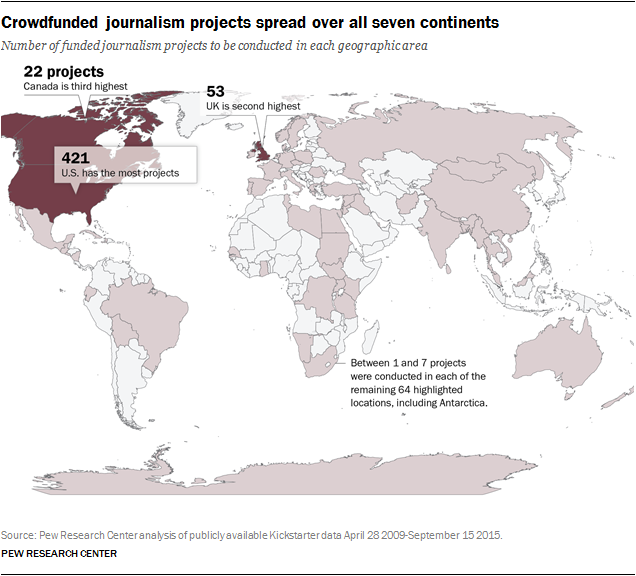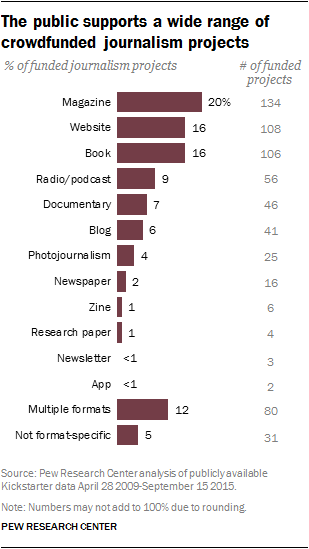

Crowdfunded Journalism: 10 Takeaways from the Pew Study
 Editor’s Note: Last week, the Pew Research Center released Crowdfunded Journalism: A Small but Growing Addition to Publicly Driven Journalism. The report highlights that, while contributions to crowdfunding journalism are modest compared with other categories, it is indeed a growing trend. The report found that crowdfunding represents a new, niche segment of nontraditional journalism, gives voice and visibility to efforts that otherwise would likely slip under the radar, provides new sources of sustainability, and contributes to public engagement.
Editor’s Note: Last week, the Pew Research Center released Crowdfunded Journalism: A Small but Growing Addition to Publicly Driven Journalism. The report highlights that, while contributions to crowdfunding journalism are modest compared with other categories, it is indeed a growing trend. The report found that crowdfunding represents a new, niche segment of nontraditional journalism, gives voice and visibility to efforts that otherwise would likely slip under the radar, provides new sources of sustainability, and contributes to public engagement.
The Pew study focuses solely on projects on Kickstarter, one of the two biggest crowdfunding platforms, and the only one that offers a distinct category of journalism (added in 2014, and retroactively assigned to earlier projects). Researchers analyzed 658 projects that received full or more than full funding, from a total 2,975.
Some criticized the study for appearing as a summary of the state of crowdfunding in journalism — when it’s far from that — and for missing the bigger picture. For example: the largest crowdfunded campaigns for journalism projects to date have not been on Kickstarter but on their own independent or local platforms. (See De Correspondent in 2013, Krautreporter in 2014 and El Español in 2015.) Also, as acknowledged in the Pew Report, the journalism category in Kickstarter is not comprehensive: there can be overlaps, and the category does not include other projects that may also be journalistic (such as publishing, photography, documentary, or podcast categories).
Nonetheless, this is a valuable study. Below you can find a summary of the 10 main findings and takeaways of the report. You can read and download the full report here.
Over the past several years, crowdfunding via the internet has become a popular way to engage public support – and financial backing – for all kinds of projects, from the Coolest Cooler to a virtual reality gaming headset to a prototype of a sailing spacecraft and a bailout fund for Greece. The area of journalism is no exception.
1. From April, 2009 to September, 2015, 658 journalism-related projects proposed on Kickstarter, received full – or more than full – funding, to the tune of nearly $6.3 million.
2. With one exception in 2013, funding grew year over year, with 52% of this – nearly $3.3 million – raised within the past two years, 2014 and 2015. This $6.3 million over the six and a half years exceeded the total funding requested for these projects ($4,907,136) by almost $1.4 million dollars.
3. Even as the Journalism category on Kickstarter has grown, it remains one of the smallest of the other 14 categories on a number of levels. Over this time period, the number of proposed journalism projects over the seven-year time frame lagged behind every category but Dance, which saw just slightly fewer proposals (2,858). And Music and Film & Video both outpace it grandly, with more than 40,000 proposed projects each. However, Dance saw the highest rate of successful funding – 64% of all projects compared with Journalism’s 22%. Here, though, Journalism is more on par with a number of other categories including Fashion, Technology and Crafts.
4. With a median of 54 backers each, the funded projects over these six and a half years varied dramatically in focus, but many were for longer, more comprehensive works in the form of books, magazine articles and documentaries. Together these types of projects accounted for 43% of the funded projects and 36% of the total dollars raised.
5. Media organizations get crowdfunding, but individuals produce largest share of funded journalism projects:
 Pew Research Center identified four types of individuals or organizations behind the crowdfunded journalism projects: single individuals, small groups of unaffiliated individuals, media outlets or organizations, and public or private institutions such as universities.
Pew Research Center identified four types of individuals or organizations behind the crowdfunded journalism projects: single individuals, small groups of unaffiliated individuals, media outlets or organizations, and public or private institutions such as universities.
- Single individuals accounted for more funded submissions than any other group – 43% over the seven-year time frame.
- Small groups of individuals accounted for another 29%.
- Roughly a quarter of funded journalism projects during this time (22%) were produced by some type of established media outlet or organization.
- Public and private institutions accounted for 7% of all the journalism proposals.
6. The total number of projects funded grew tenfold over time, from a total of just 17 that received full funding in 2009 to 173 in 2015. With the exception of 2013, single individuals held the greatest share of total projects, ranging from 30% to 59%, while institutions held fairly steady at between 5% and 9% over time. Groups of individuals did not show much fluctuation in their share of total projects, remaining in the 25-35% range in all years. Media organizations ranged between a low of 6% of all projects in 2009 and a high of 36% in 2013.
The amount of money put into these projects grew as well, from $49,256 in 2009 and $263,352 in 2010 to $1,743,668 in the first nine months of 2015.
7. Equally striking is the upward trend in the number of people contributing financially to these journalism projects – rising from 792 in 2009 to 25,651 in 2015.
8. Sustained and longer-form journalism stand out in funded projects: Researchers found a total of 14 different media formats represented in the journalism projects. The most common ones tend to be larger and longer enterprises that would not be possible without the support of independent donors.
9. Projects funded through Kickstarter cut across more than 60 countries.
10. Roughly a third of journalism projects were focused outside the U.S. 64% of the funded Kickstarter journalism proposals were for projects to be conducted within the borders of the United States, while 34% were to be conducted in foreign countries.
Excerpted with permission from Crowdfunded Journalism: A Small but Growing Addition to Publicly Driven Journalism, by the Pew Research Center Journalism & Media program, January 20, 2016.














